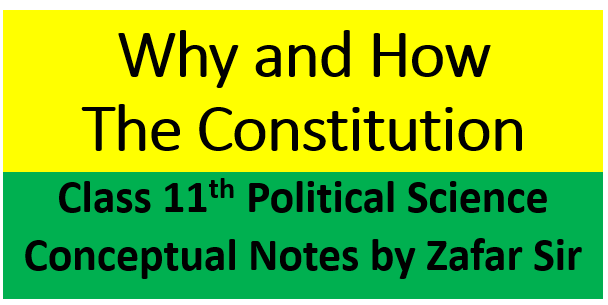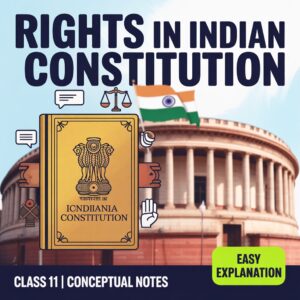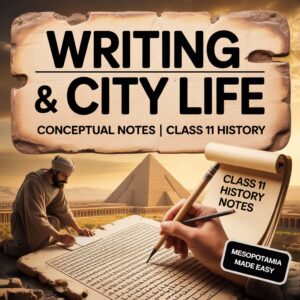
What is the Constitution?
- The collection of rules and laws related to the governance of any country is called the constitution. Through this, the government of that country has sovereignty (dependent on itself or dependent on the constitution) and whatever rules and laws it makes, the people automatically follow them.
Types of Constitution in the world
There are mainly two types of constitution found in the world
- A written Constitution
- Unwritten Constitution
Written Constitution
- Written constitution is the constitution which is definitely created by a constituent assembly it is called a written constitution.
- Example- India, America & Japan
UN-Written Constitution
- An Unwritten constitution is a constitution which is not created by any constituent assembly but is a proof of traditions and laws passed from time to time decisions etc
- Example-Britain, New Zealand, Israel
Functions & Constitutions
- The Constitutions establish the three major organs of the government of a state
- Legislature, executive, and Judiciary
- The constitutions explains the powers of the three organs of government and also sets the limit of their duties
- The Constitutions regulates the mutual relations between the three organs of government and their relations with the people
- The Constitution works to fulfill the specific social, political, and economic nature, beliefs and aspirations of the people and prevents anarchy
Need for Constitution - Man is a social animal , society is made up of different types of communities .constitution is necessary to maintain coordination among these communities
- The constitution provides a set of fundamental rules to create mutual trust among the people
- Who will have the power to take the final decision? The constitution decides this.
- The Constitution determines is also necessary for the establishment of a just society
World Constituent Assembly - The first person to give the Idea of Constitution Assembly in the world was Britain/ British Citizen Sir Henry Maine
- The first Constituent Assembly in the world was formed in Philadelphia, USA in 1786. At that time there were 13 states in America which together made in Constitution of America
- After this the Constitution assembly was formed in France in 1789
- The First constitution in France was written in 1793
Cripps Mission
- It was sent to India in March 1942 By British Prime Minister Churchill under the leadership of British Parliament member and labor leader Sir Stafford crips with the aim of removing the political deadlock in India
- However the real Purpose of this mission was to persuade the Indians to cooperate in the war. Sir Cripps was also a member of the British war cabinet and actively supported The Indian National movement
- On behalf of the congress Jawaharlal Nehru and Maulana Abul Kalam Azad were authorized to examine and discuss the Cripps Mission
Constituent Assembly of India
- The Person who gave the Idea of Constituent Assembly in India was MN ROY
- 1895- As far as India is concerned the first glimpse of the constituent assembly in India was seen in the Swaraj Bill of 1895 which was prepared under the guidance of Bal Gangadhar Tilak
- 1922-In 1922 Mahatma Gandhi was the first person who gave a speech in the Constituent Assembly
- 1924-The first person to demand a constituent Assembly in 1924 (in 1924 AD) was Pt.Motilal Nehru (his father name was Dada Gangadhar Nehru who was the kotwal of Lal Quila in Delhi during the 1857 revolution )
- 1924-1934 Swaraj party was the first political party in which the demand for constituent assembly was made twice in 1924 and 1934
- 1936- Congress was established on 28th December 1885 congress for the first time talked about the importance of the Constitution of India in Luck now session of 1936
- This session was presided over by Pt.JawaharLal Nehru (at that time the initial workers of congress were 72 )
- 1940-in August 1940 British Prime minister Churchill was the first person who said that the people of India themselves will prepare the Constitution of India
Formation Process of the Indian Constituent Assembly
- 1942 Britain proposed a constituent Assembly on a theoretical basis in 1942 through the Cripps Mission plan but the Cripps proposal was rejected by all political parties for this reason a constituent Assembly could not be formed here
- 1945-In July 1945 the New Labour Party government came to power in England then the way was opened for the formation of the Indian constituent Assembly Viceroy Lord Wavell Confirmed this
- 1946-The Practical form of the Cripps proposal was given in the name of the Cabinet Mission plan of 1946 and on this basis the elections of the constituent Assembly was held in July 1946
- According to the Cabinet Mission plan The number of members of the constitution making body was fixed at 389 out of which 292 representatives were to be taken from the eleven prominence under the governors of British India 04 representatives from the four provinces of Chief Commissioners (Delhi, Ajmer, Mar war coorg and British Baluchistan ) and 93 representatives from the Indian Princely states
- Each Province of the British Empire was given seats in the Constituent Assembly in proportion to their population (one seat per 10 lakh people )
- The Seats in each Province were divided among the three major communities Muslims, Sikhs, and General in proportion to their population
- June 3 1947-according to the Mountbatten Plan the partition of India and Pakistan was decided as a result the member of Pakistan were no longer members of the Constituent Assembly and the actual number of members of the Indian Constituent Assembly remained 299
Form of the Constituent Assembly
- The Constituent Assembly was formally inaugurated on Monday 9 December 1946 at 11 am.
Sessions of the Constituent Assembly First Session - The first session of the Constituent Assembly was held on 9 December 1946 , 209 members attended this meeting
- On 9 December 1946 Dr. Sachchidanand Sinha was appointed temporary president
Second Session - The second session of the Constituent Assembly was held on 11th December 1946
- During this session on 11th December 1946 Dr Rajendra Prasad was elected the permanent president of the constituent Assembly and Dr.Bhimrao Ambedkar was elected the chairman of the constitution Drafting committee
- On 13th December 1946 Pandit Jawaharlal Lal Nehru presented the objective proposal of the constitutional. In this the outline of the future sovereign democratic republic of India was presented which was accepted by the constituent Assembly on 22nd January 1947
Fourth Session - The fourth session of the Indian Constituent Assembly lasted from 14th July 1947 to 31st July 1947.During this session the national flag tricolor was adopted on 22nd July 1947
- The Indian Constitution adopted on 26th November 1949 had 395 articles 22 parts and 8 schedules and 3 appendixes. At present the schedules have increased from 8 to 12
- Till 25th July 2017 there were 465 articles and on 31st December 2017 it became 465
- The Indian Constitution adopted on 26th November 1949 was formally implemented on 26th January 1950
- There were 299/300 members in the Constituent Assembly out of which 284 members were present on 26th November 1949. These 284 members had signed the final constitution.
- Every motion every word and everything said in the assembly was recorded and published in 12 thick volumes titled constituent / Assembly debates
Total time and total meetings in the making of the Indian Constitution
- It took 2 years 11 months and 18 days to make the constitution and a total 166 meetings were held and about 64 lakh rupees were spent in making the constitutions
Schedules Currently in the Indian Constitution - There are 12 schedules
Women members in the constituent Assembly
- There were a total of 9 women members in the constituent assembly , three of them were very Important who were on many committees , Sarojini Naidu Hansa Mehta Durgabai Deshmukh and others were Rajkumari Amrita Kaur Begum Ejaz Rasul VijayaLakshmi
Drafting Committee of the Constituent Assembly - On 29th August 1947 a seven member committee was formed under the chairmanship of Dr. Bhimrao Ambedkar. This committee presented the
draft of the constitution to the constituent assembly chairman on 21 February 1948
Process of Formation of Indian Constituent Assembly
- First meeting 9 December 1946 Dr Sachidananda was the temporary president
- Cabinet mission proposal
- 11 December 1946 Dr. Rajendra Prasad appointed as Permanent President
- Member Number 389 (292+4+93)
- 14 August 1947 Divided India constituent assembly meeting total meetings 166
Four Shortcomings in the formation of the Indian Constituent Assembly - Lack of sovereignty
- Improper classification of states
- The native princely states were not forced to accept the constitution
- The member of the constituent Assembly were selected undemocratically
Introduction - The permeable is the essence of the thoughts of the objective of the constitution maker it is also called the preamble its basis is considered to be the objective resolution
3 types of Justice have been used in Preamble
• Social Justice
• Economic Justice
• Political Justice
Social Justice
• Social Justice has been given a fundamental place, especially in the right to equality
Economic Justice
• Economic Justice has been given a place in the directive principles of policy
Political Justice
• For Political Justice the right to vote and the right to contest elections have been given
Three new words were added to the preamble by the 42nd constitutional Amendment Act 1976
• Socialism
• Secularism
• Integrity (Unity & Integrity )
Sources of the Indian Constitution
- About 75% of the constitution was taken from the Government of India Act 1935
- 10 fundamental human rights were included from the Motilal Nehru committee report appointed 1928
- Some things from the constitutional system of other countries were also incorporated in the constitution of India such as
British Commission
The Victory in the election is decided based on the highest number of votes
Parliamentary form of government
- The idea of the rule of Law
- The position of the speaker in the legislature and his method of lawmaking
Constitution of America
- List of fundamentals rights
- Power of judicial review and independence of the Judiciary
Constitution of Ireland
- Directive Principles of state policy
Constitutions of France
- The Principle of liberty, equality and fraternity
Constitutions of Canada - A quasi-federal form of government (a federal system with a strong central government )
- Doctrine of residuary powers
Features of the constitution
- A complete constitution written and made by the peoples representatives
- This create a completely sovereign democratic socialist secular republic
- Reminds citizens of their fundamental duties along with fundamental rights
- There is an independent judiciary
- Parliamentary system of government
- Directive principles of state policy etc
Constitution of India is strict
- The Constitution is rigid according to article 368 in addition to a two thirds majority of the members of parliament the support of at least half of the state legislative assemblies is necessary for amendments in certain subjects (special Majority )
Indian Constitution Flexibility
- The Indian Constitution is flexible because many of its amendment provisions amended by passing them with simple majority in the Parliament
Expansion of words mentioned in the Preamble of the Indian Constitution Justice
- Providing social economic and political justice
Freedom
• Freedom of expression thought belief religion action and worship
Equality
• End of all types of discrimination or freedom from discrimination
Brotherhood
• To create feelings of mutual love /affection among every citizens of the country
Secularism
• Freedom for citizens of all religious beliefs to practice religion
Socialist
• The aim of the government is to do maximum public welfare , social welfare work , public welfare work , society is supreme
Single Citizenship
• Single citizenship means that people in a state have only one citizenship states with federal governance usually have dual citizenship but in India despite having a federal governance citizens here have only single citizenship
Constitution making dispute in Nepal
• Since 1948 five constituent have been made in Nepal 1948, 1951, 1959, 1962, 1990, 2006
• There is still opposition to the constitution made after 1948. Currently the Madhesi movement is protesting against it. Most of the people want amendments in the constitution
Fundamental provisions of a successful constitution
• Every person have a reason to respect the provisions of the constitution
• Ensuring social security of minorities from the majority and providing them equal facilities
• Strengthening the power of small social groups
• To protect the freedom of everyone in the society
When was the constitution of South Africa made?
• The constitution of south Africa was made in December 1996
Global Problems included in the constitution of South Africa
• Environmental protection class discrimination housing problem health problem global poverty



